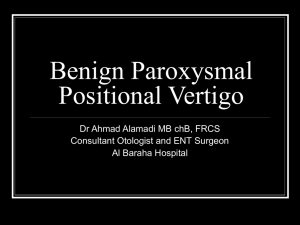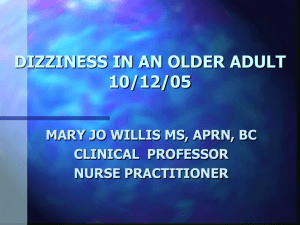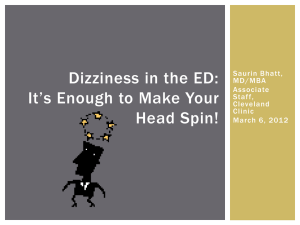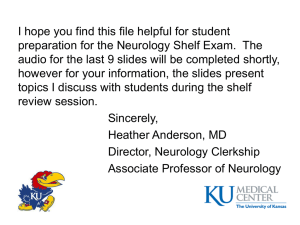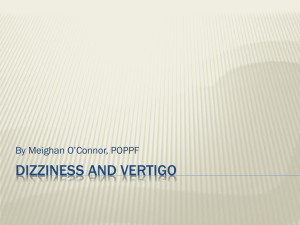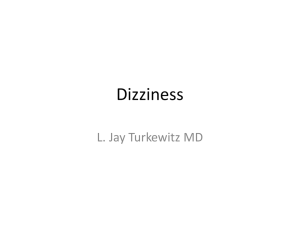Approach to the dizzy patient
advertisement
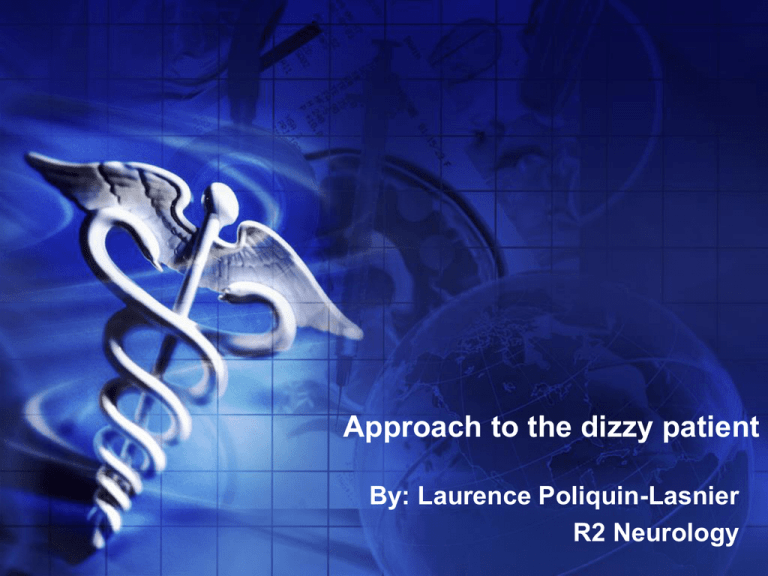
Approach to the dizzy patient By: Laurence Poliquin-Lasnier R2 Neurology What Dizzy means? • Illusory movement of the environment (vertigo) • Lightheadedness • Imbalance • Pre-syncope Questions to ask • • • • • Constant or episodic Associated symptoms Gradual vs sudden onset Aggravating/alleviating symptoms Duration and frequency of attacks if episodic • Triggers Distinguishing vertigo from other types of dizziness • Time course – Vertigo is never continuous – The CNS adapts to the defect so that vertigo subsides over several wks Distinguishing vertigo from other types of dizziness • Provoking factors – Certain vertigo occur spontaneously, while others are precipitated by maneuvers that change head position or middle ear pressure ( coughing, sneezing, or Valsalva maneuvers) – Positional vertigo and postural presyncope are both are associated with dizziness upon standing – Determine whether dizziness can be provoked by maneuvers that change head position without lowering BP or decreasing cerebral blood flow – Such maneuvers include lying down, rolling over in bed, and bending the neck back to look up Distinguishing vertigo from other types of dizziness • Aggravating factors – All vertigo is made worse by moving the head – Many patients in the midst of a vertiginous attack are petrified to move – If head motion does not worsen the feeling, it is probably another type of dizziness Key point • Any type of dizziness may worsen with position change but disorders such as benign positional vertigo only occur after position change Causes of dizziness • Peripheral • Central • Systemic Peripheral causes Hx Duration Associated symptoms Physical Vestibular neuritis/labyri nthitis Single prolonged episode Days Nausea, imbalance Peripheral nystagmus, + head thrust, imbalance BPV Positionally triggered episodes < 1 min Nausea, ask for history of trauma Positionally triggered burst of nystagmus Ménière disease May be triggered by salty food hours Unilateral ear fullness, tinnitus, hearing loss, nausea Unilateral low frequency hearing loss Vestibular paroxysmia Abrupt onset, spont or positionally triggered seconds Tinnitus, hearing loss normal Perilymphatic fistula Triggered by sound seconds or pressure change or physical strain Hearing loss, hyperacusis, ask for history of trauma Nystagmus with change in pressure Vestibular Neuritis • • • • Young adults Severe vertigo of rapid onset Nausea, vomiting, imbalance Symptoms gradually resolve over several days • Probably viral etiology • Generally benign, self-limited course Benign paroxysmal positional vertigo • Most commonly recognized cause of vertigo • Calcium debris within the posterior semicircular canal (canalithiasis) • Brief spinning sensation brought on when turning in bed or tilting the head backward to look up • Dizziness is quite brief, usually secs, rarely mins • May be severe enough to halt activity for this duration • Dix-Hallpike maneuver can provide further evidence of its presence, but is positive in only 50 to 80% of patients • Natural hx of BPPV is one of repeated, brief vertiginous episodes that are predictably provoked and continue for wks or months Ménière’s disease • Reccurent attacks of vertigo associated with auditory symptoms (hearing loss, tinnitus, aural fullness) • Attacks variable in duration, most last > 20 min • Severe nausea and vomiting • Progressive hearing loss • Bilateral ménière in 1/3 of patients • Caused by hydrolymphatic hydrops • Can get acute episodes of falling/being pulled to the ground caused by acute stimulation of otolith “otolithic catastrophes of Tumarkin” Vestibular paroxysmia • Brief episode of vertigo lasting seconds • No trigger • Thought to be 2ary to spontaneous discharges from damaged VIII cranial nerve Vestibular fistula • Tear or defect in the oval window and/or the round window (membranes that separate the middle ear from the fluidfilled inner ear) • Changes in middle ear pressure will directly affect the inner ear, stimulating the balance and/or hearing structures and causing symptoms Acoustic neuroma • Very rare to have vertigo as it is slow growing so that the CNS has time to adapt and compensate • Mostly unilateral hearing loss Central Causes Hx Duration Associated symptoms Stroke/Tia Abrupt onset >24hrs vs Brainstem, minutes cerebellar Central nystagmus, focal neuro signs Multiple sclerosis Subacute onset Min-wks Central, peripheral or positional nystagmus Unilateral vision loss, diplopia ataxia Physical exam Neurodegen Spontaneous erative or positionally disorder triggered Min-hours ataxia Central/ peripheral nystagmus, cerebellar, extrapyramidal, frontal signs Basilar migraine Onset with typical migraine triggers Seconds to days Headache, Peripheral/ central/ visual aura, positional nystagmus photo/phonop hobia Familial ataxia syndromes Acutesubacute, episodic type with stress, exercise hours ataxia Central/ positional Brainstem/cerebellar infarct • Vertigo is a common symptom in Wallenberg syndrome/PICA infarct • Associated with diplopia, horner, crossed pain & temp loss • Vertigo may be the only symptom in cerebellar infarct • Oculomotor testing can show: 1- Pure unidirectional nystagmus 2- Direction-changing gaze evoked nystagmus 3- Impaired smooth pursuit 4- Overshooting saccades Multiple Sclerosis • May be the initial symptom in 5% of patients • Can get almost any type of vertigo, including peripheral vertigo when plaque affects root entry zone of the vestibular nerve Neurodegenerative disorder • • • • • Parkinson Progressive supranuclear palsy Multi-system atrophy Progressive ataxia disorders Dizziness in these patients often better clarified as imbalance Posterior fossa structural abnormalities • Chiari malformation causes pressure on cerebellum • Unsteadiness of gait may be described as dizziness by patients • Vertigo is rare • Posterior fossa tumor (eg medulloblastoma, gliomas) Migraine • Benign recurrent vertigo may be considered as a migraine equivalent • With typical migraine triggers • + family history • Normal neuro exam • No progressive hearing loss Familial ataxia syndromes • Spinocerebellar ataxia • Friedreich ataxia • Episodic ataxia • + oscillopsia Systemic causes • Medications • Hypotension, presyncope • Infectious diseases (eg.: syphilis, viral, bacterial meningitides & systemic infection) • Endocrine diseases (eg.: DB/hypoglycemia & hypothyroidism) • Vasculitis (eg.: collagen vascular disease, giant cell arteritis, drug-induced vasculitis) • Hematological disorders • Hyperventilation, panic attack On exam: • • • • Postural vitals General physical exam General neuro exam Neuro-otological exam Neuro-otological exam • Ocular motor function testing – Look for spontaneous nystagmus or saccadic intrusions – Nystagmus suggests that the dizziness is vertigo • Gaze testing – Look for gaze-evoked nystagmus – Normal to have non-sustained nystagmus with gaze greater than 30 degrees – Vertical nystagmus that increases with lateral gaze localizes to craniocervical junction and midline cerebellum Nystagmus Feature Central Peripheral Latency none 2-15 sec Duration > 30 sec 5-30 sec Fatiguability +/- ++ Vertigo Usually absent Usually present Fixation No suppression suppression Direction Vertical or horizontal, direction may change with head position Unidirectional, Horizontal or rotatory, fast phase toward normal ear, increased with gaze in direction of fast phase Neuro-otological exam • Smooth pursuit – Voluntary mvt of of the eyes used to track a target moving at a low velocity – Look for saccadic pursuit – May occur with early/mild cerebellar degenerative disorders as the only finding with minimal ataxia Neuro-otological exam • Saccades – Fast eye mvts used to quickly bring the image of an object on the fovea – Shift gaze from one object to another under voluntary control – Slowing of saccades = lesion in pons/midbrain, oculomotor neuron or extraocular muscles – Overshooting saccades = ocular dysmetria, sign of cerebellar lesion – Undershooting saccades less specific and occur in normal people Neuro-otological exam • Optokinetic nystagmus – Combination of fast saccadic and slow smooth pursuit observed in N people observing a moving object – Patients with severe slowing of saccades will not be able to generate OKN and will have their eyes pinned on one side • Vestibulo-ocular reflex suppression – Normal individual can fixate his thumb while pt being turned on himself – Will elicit nystagmus in pts who have impaired smooth pursuit Vestibular nerve exam • Head thrust test – When quickly unpredictably turn head of patient by 30 degree on side, eyes will go on opposite direction (vestibulo-ocular reflex) to continue to fixate target – Abnormal vestibulo-ocular reflex if observe corrective saccade bringing eyes back to target after head thrust – Sensitivity 71% and specificity 82% Positional testing • Dix-Hall-Pike – Burst of upbeat, torsional nystagmus triggered in patients with BPV by rapid change from erect sitting to supine headhanging right or left • Epley manoeuver – More than 80% effective in treating patients with posterior canal BPPV Epley Maneuver Epley maneuver • Key feature is the roll-across in the plane of the posterior canal so that the clot rotates around the posterior canal and out into the utricle Fistula testing • Test for it if patient reports sound or pressure induced dizziness • Pressing or releasing the tragus will trigger nystagmus • Other variant with valsava Gait assessment • Wide based gait • Acute vestibular loss may cause the patient to lean on the side of the affected ear Auditory examination • Otoscopy • Whisper test (stand behind to prevent lip reading and occlude/mask the non-tested ear by finger rub or occluding external auditory canal) • Whisper 3-6 numbers or letters • Normal if can repeat 50% • Weber: lateralizes to ipsi conductive impairment or contralateral sensorineural • Rinne: if bone conduction > air conduction = ipsi conductive hearing loss Conclusion • Clarify what dizzy means • Be patient as history is the most important part, physical is confirmatory • Peripheral vs central vs systemic causes • General physical and neuro exam • Neuro-otological exam - Ocular mvts/nystagmus - Head-thrust - Dix-Hall pike
